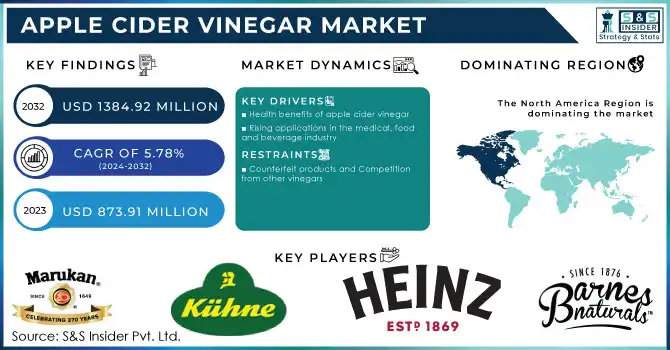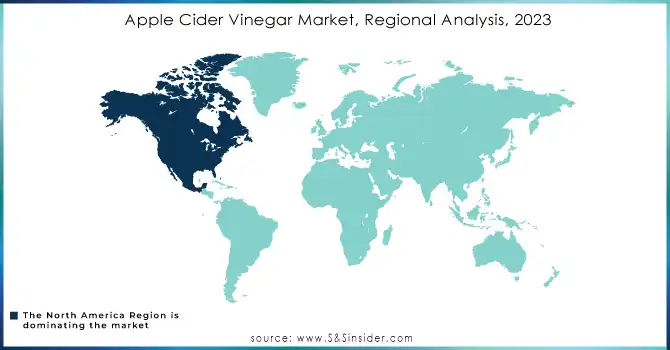Apple Cider Vinegar Market Key Insights:

Get More Information on Apple Cider Vinegar Market- Request Sample Report
The Apple Cider Vinegar Market size was valued at USD 873.91 million in 2023 and is expected to grow to USD 1384.92 million by 2032 with a growing CAGR of 5.78% over the forecast period of 2024-2032.
The vinegar created from fermented apples is known as apple cider vinegar. It is frequently used in cooking and salad dressings and has a pungent, sour flavor. Additionally, ACV has been used for millennia as a home treatment for several medical issues.
Apple cider vinegar improves fat-burning and weight loss, lowers blood sugar levels, and aids in cholesterol reduction. As a result of the rising obesity rate in various countries boosts the demand for apple cider vinegar as a simple and healthy solution to fight obesity. Companies are well-positioned to meet this demand by targeting this developing trend. As a result, manufacturers are capitalizing on this tailwind to expand their customer base through inventiveness, distribution advancement, and increased product awareness.
By form type, the liquid segment Apple cider has the highest market segment. Apple cider has the most market share. This is mostly due to its ease of use and widespread availability in the market via various distribution channels such as supermarkets, hypermarkets, specialty stores, and others. However, the other segment is predicted to be the fastest-growing segment in terms of value sales during the forecast period.
MARKET DYNAMICS
KEY DRIVERS
-
Health benefits of apple cider vinegar
-
Rising applications in the medical, food and beverage industry
Many websites and practitioners of natural healthcare believe that apple cider vinegar offers extraordinary health benefits, such as boosting energy and preventing illness. Vinegar can help eliminate infections, including certain bacterium types. As a result, vinegar has traditionally been used for disinfecting and cleaning, as well as treating nail fungus, lice, warts, and ear infections. Vinegar is also used as a food preservative in the food and beverage industries.
Hippocrates, the father of modern medicine, utilized vinegar to treat wounds for almost 2,000 years in the medical field. One of the most compelling applications of vinegar is in the treatment of type 2 diabetes. Apple cider vinegar may help with lowering blood sugar, decreasing insulin levels, and weight loss by increasing satiety. Some people use apple cider vinegar to treat skin disorders such as eczema and dry skin.
RESTRAIN
-
Counterfeit products and Competition from other vinegars
There are numerous counterfeit Apple cider vinegar products in the market. Such products may not contain the same components as genuine Apple cider vinegar and may be unsafe to eat. It is critical to purchase Apple cider vinegar from a trusted provider. Other vinegar available on the market include white vinegar, red wine vinegar, and balsamic vinegar. These vinegars can be used for the same purposes as apple cider vinegar and may be less expensive.
OPPORTUNITY
-
Increasing commercial applications of ACV on a large scale
ACV is used in a range of food and beverage products as a preservative and flavoring agent, including salad dressings, sauces, pickles, and smoothies. ACV is found in many personal care products, such as shampoos, conditioners, soaps, and lotions. It has astringent and antibacterial characteristics that can help cleanse and protect the skin and hair. ACV is a natural cleaning product that may be used on a range of surfaces, including countertops, floors, and windows. It is non-toxic and biodegradable, and it is reported to be good at removing filth, grease, and grime. ACV is applied to plants as a foliar spray to help protect them from pests and illnesses. It is also supposed to aid in the growth and yield of plants. Other commercials such as metal finishing, leather tanning, and textile dyeing are the drivers of market growth.
CHALLENGES
-
Negative impacts of ACV on prolonged consumption
When consumed in moderation, apple cider vinegar is often harmless for the majority of people. However, there are some potential harmful consequences of prolonged usage, such as Apple cider vinegar is acidic, and ingesting too much of it can irritate the stomach and esophagus linings, resulting in heartburn. It also produces nausea, especially when ingested on an empty stomach. Apple cider vinegar's acidity can dissolve tooth enamel over time, resulting in tooth disease. Certain drugs, such as insulin and blood thinners, may interact with apple cider vinegar. Before eating apple cider vinegar, proper consultation should be taken with a doctor.
IMPACT OF RUSSIAN-UKRAINE WAR
The Russian-Ukrainian conflict is predicted to have a large influence on the apple cider vinegar market. The dispute is expected to disrupt supply chains and raise transportation costs, potentially leading to higher apple cider vinegar prices. The war may also restrict the availability of apple cider vinegar since some producers may be unable to operate as a result of the fighting. The war may also shift demand for apple cider vinegar away from apple cider vinegar and toward white vinegar, red wine vinegar, and balsamic vinegar, as customers may be more willing to purchase items that are perceived to be more economical or accessible.
IMPACT OF ONGOING RECESSION
The recession has led to a decrease in sales of vinegar affecting the apple cider market to slow down. During a recession, consumers may shift their desire to more affordable products, which could contribute to an increase in demand for lower-cost apple cider vinegar brands. Due to the health benefits of apple cider vinegar, the demand in the market is stagnant but production may be delayed due to a rise in prices. Consumers may be less likely to purchase apple cider vinegar during a recession, as they may be focusing on more essential purchases. Over the last five years, the export price of Vinegar from India has steadily increased.
MARKET SEGMENTATION
by Source
-
Organic
-
Conventional
by Form
-
Liquids
-
tablets/Capsules
by Distribution Channel
-
Department Stores
-
Super Market/Hypermarket
-
e-commerce
-
others
by Application
-
Food and Beverages
-
Pharmaceuticals
-
Personal Care
-
Others
REGIONAL ANALYSIS
North America is the largest market for apple cider vinegar with a market value of USD 303.4 million in 2022. The region has a strong presence due to large vinegar manufacturers. The U.S. is the largest market followed by Canada in North American region. The growth of the apple cider vinegar market in North America is driven by the increasing demand for natural and organic products, the rising awareness of the health benefits of apple cider vinegar, and the increasing disposable income of consumers.
The Asia Pacific apple cider vinegar market is likely to hold a significant share. The industry is being pushed by rising vinegar use due to its health benefits. In the Asia-Pacific region, it is extremely popular. Because of its health benefits, customers in the region take it directly by mixing it in water. It is also used in a variety of Japanese and Chinese dishes as marinades, dressings, or sauces, adding a tangy flavor to the dish.
The increasing use of cider vinegar in the food industry in the European market is expected to drive market growth. Furthermore, the growing vegan population and rising demand for plant-based foods are expected to drive demand for organic cider vinegar market.

Need Any Customization Research On Apple Cider Vinegar Market - Inquiry Now
REGIONAL COVERAGE
North America
-
US
-
Canada
-
Mexico
Europe
-
Eastern Europe
-
Poland
-
Romania
-
Hungary
-
Turkey
-
Rest of Eastern Europe
-
-
Western Europe
-
Germany
-
France
-
UK
-
Italy
-
Spain
-
Netherlands
-
Switzerland
-
Austria
-
Rest of Western Europe
-
Asia Pacific
-
China
-
India
-
Japan
-
South Korea
-
Vietnam
-
Singapore
-
Australia
-
Rest of Asia Pacific
Middle East & Africa
-
Middle East
-
UAE
-
Egypt
-
Saudi Arabia
-
Qatar
-
Rest of Middle East
-
-
Africa
-
Nigeria
-
South Africa
-
Rest of Africa
-
Latin America
-
Brazil
-
Argentina
-
Colombia
-
Rest of Latin America
KEY PLAYERS
Barnes Natural, H.J. Heinz Company Brands LLC, Carl Kühne KG, Old Dutch Mustard Company, Marukan Vinegar Inc, General Nutrition Centers, Inc, White House Foods, Vitane Pharmaceuticals, Inc, Higher Nature Ltd, Bragg Live Food Products, LLC, and other key players are mentioned in the final report.
RECENT DEVELOPMENTS
In 2023 Renovatio, a health and wellness brand, expands into pantry goods with the introduction of freshly activated apple cider vinegar at Woolworths stores across the country.
In 2022, Molson Coors-owned apple cider company Aspall Cyder invested USD 16 million in modernizing its 300-year-old facility in the UK. The investment has raised annual production by around 60% to approximately 70 million pints of cider.
In 2022, Bragg True Energy Apple Cider Vinegar is a new supplement from Swander Pace Capital LLC's Bragg Live Food Products Inc. The supplement contains apple cider vinegar as well as six vital vitamins to help with cellular energy.
| Report Attributes | Details |
| Market Size in 2023 | US$ 873.91 Million |
| Market Size by 2032 | US$ 1384.92 Million |
| CAGR | CAGR of 5.78% From 2024 to 2032 |
| Base Year | 2023 |
| Forecast Period | 2024-2032 |
| Historical Data | 2020-2022 |
| Report Scope & Coverage | Market Size, Segments Analysis, Competitive Landscape, Regional Analysis, DROC & SWOT Analysis, Forecast Outlook |
| Key Segments | • By Source (Organic, Conventional) • By form (Liquids, tablets/Capsules) • By Distribution Channel (Department Stores, Supermarket/Hypermarket, e-commerce, and others) • By Application (Food and Beverages, Pharmaceuticals, Personal Care, Others) |
| Regional Analysis/Coverage | North America (US, Canada, Mexico), Europe (Eastern Europe [Poland, Romania, Hungary, Turkey, Rest of Eastern Europe] Western Europe] Germany, France, UK, Italy, Spain, Netherlands, Switzerland, Austria, Rest of Western Europe]), Asia Pacific (China, India, Japan, South Korea, Vietnam, Singapore, Australia, Rest of Asia Pacific), Middle East & Africa (Middle East [UAE, Egypt, Saudi Arabia, Qatar, Rest of Middle East], Africa [Nigeria, South Africa, Rest of Africa], Latin America (Brazil, Argentina, Colombia Rest of Latin America) |
| Company Profiles | Barnes Natural, H.J. Heinz Company Brands LLC, Carl Kühne KG, Old Dutch Mustard Company, Marukan Vinegar Inc, General Nutrition Centers, Inc, White House Foods, Vitane Pharmaceuticals, Inc, Higher Nature Ltd, Bragg Live Food Products, LLC |
| Key Drivers | • Health benefits of apple cider vinegar • Rising applications in the medical, food and beverage industry |
| Market Challenges | • Negative impacts of ACV on prolonged consumption |

